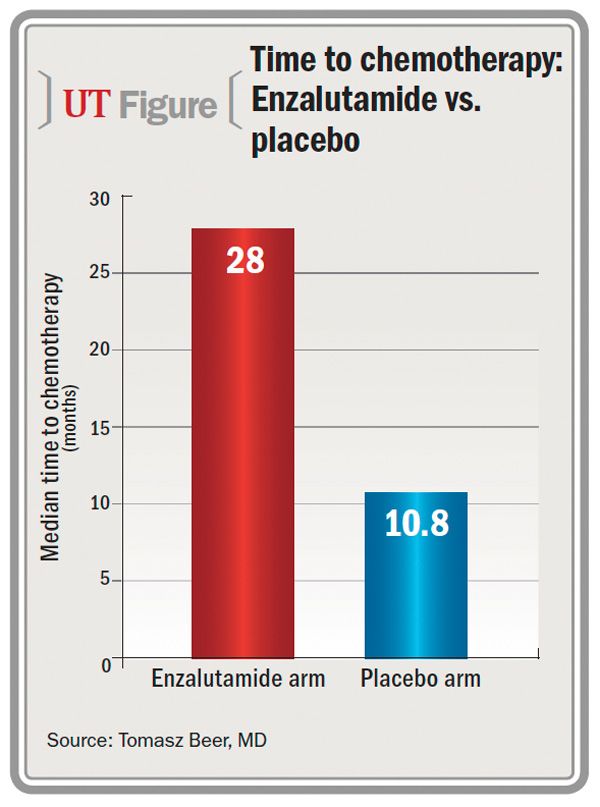Article
Anti-androgen shows benefit in pre-chemo setting
The second-generation androgen receptor antagonist enzalutamide (XTANDI) significantly improved survival and delayed the time to chemotherapy in men with previously untreated metastatic castrate-resistant prostate cancer, according to a recent study.
San Francisco-The second-generation androgen receptor antagonist enzalutamide (XTANDI) significantly improved survival and delayed the time to chemotherapy in men with previously untreated metastatic castrate-resistant prostate cancer (mCRPC), according to a recent study.
Compared with placebo, treatment with enzalutamide was associated with a near 30% reduction in the risk of death and a marked decrease in the risk of radiographic progression, according to first author Tomasz Beer, MD, professor of medicine and deputy director of the Knight Cancer Institute at Oregon Health & Science University, Portland.
These data are from the phase III international PREVAIL study, the results of which Dr. Beer presented at the Genitourinary Cancers Symposium in San Francisco.
Enzalutamide is already approved by the FDA in patients with mCRPC, but only in the post-docetaxel (Taxotere) setting.

Continue to next page for more.
PREVAIL is a double-blind, placebo-controlled study of 1,717 men with asymptomatic or mildly symptomatic mCRPC who were chemotherapy naïve. They were randomized to enzalutamide or placebo plus standard hormone therapy. Participants had previously received treatment with hormone therapy, typically with a luteinizing hormone-releasing hormone agonist with or without a first-generation anti-androgen and, when indicated, treatment for the primary tumor (ie, surgery or radiation therapy). About 12% of the patients enrolled had metastases to the liver and/or lung.
“The study was stopped early by the independent data safety monitoring committee [DSMC] for superior efficacy and overall benefit-to-risk ratio, and the DSMC recommended that placebo patients be crossed over to enzalutamide,” said Dr. Beer.
At the time of the interim analysis at a median follow-up of 22 months, enzalutamide was associated with a 29% reduction in the risk of death, with an estimated median overall survival of 32.4 months in the enzalutamide arm versus 30.2 months in the placebo arm (p<.0001). Because the median follow-up was approximately 10 months shorter than the estimated median survival-and 72% of enzalutamide-treated patients were still alive at the time of the analysis-the estimate of median survival is not robust and the hazard ratio is a more accurate expression of the survival differences seen in the trial.
The improvement in overall survival came despite a greater proportion of patients from the placebo arm receiving at least one subsequent life-extending therapy compared with the enzalutamide arm (70.3% vs. 40.3%). In addition, enzalutamide was associated with an 81% reduction in the risk of radiographic progression (p<.0001).
Time to chemotherapy ‘striking’
“A pragmatic measure of real-world treatment effect is time to chemotherapy,” Dr. Beer said. “Enzalutamide delayed the median time to chemotherapy by 17 months-28 months in the enzalutamide arm versus 10.8 months in the placebo arm. The radiographic progression-free survival and the time to chemotherapy are quite striking and represent the direct effect of therapy that is not contaminated by subsequent treatment post-progression. Although the survival advantage with enzalutamide is reassuring, it incorporates the effects of subsequent treatments into the outcome.”
Among the approximately 800 men with measurable disease at baseline, enzalutamide yielded an objective response rate of 58.8% compared with 4.9% in the placebo arm (p<.0001). A complete response was achieved in 19.7% of patients randomized to enzalutamide versus 1% randomized to placebo.
Enzalutamide was well tolerated, Dr. Beer said. Six percent of patients in each arm withdrew from the study because of side effects. The most common adverse events reported with enzalutamide were fatigue, back pain, constipation, and arthralgia, most of which were low grade. Cardiac adverse events and hypertension, most of which were low grade, were slightly more prevalent in those randomized to enzalutamide. Seizures were reported in two patients-one from each study arm.
“It is important to recognize that the observation period for safety data collection was more than three times longer for the enzalutamide arm than the placebo arm, reflecting the treatment effect of enzalutamide,” said Dr. Beer.
The initial treatment choice in chemotherapy-naïve mCRPC may eventually come down to factors such as toxicity and convenience, he said.
“Abiraterone [ZYTIGA] and enzalutamide have both been shown to be beneficial in this setting. I do think that the results of PREVAIL are sufficiently compelling to make a case for enzalutamide, but I can’t determine whether one drug is more advantageous than another without a head-to-head study. We saw very little liver abnormalities and no hypokalemia, so the intensity of monitoring with enzalutamide is probably a little less,” Dr. Beer said.
In addition, enzalutamide doesn’t require concomitant administration of a corticosteroid, like abiraterone does, and no food restrictions are necessary. For patients with a history of or risk factors for seizures, abiraterone may hold an edge, Dr. Beer said.
Dr. Beer has received research funding from Astellas Pharma, Cougar Biotechnology, Janssen Biotech, and Medivation. Several of his co-authors have received honoraria and/or research funding from, own stock in, serve as consultants/advisers for, and/or have an employment or leadership position with Astellas Pharma, Janssen Biotech, Medivation, and/or Sanofi.UT
Like this article? Check out these other recent Urology Times articles:
Supplements may raise high-grade prostate cancer risk
Prostate cancer treatment type strongest predictor of complications
Insurers expand coverage of prostate cancer tests
Subscribe to Urology Times to get monthly news from the leading news source for urologists.
Newsletter
Stay current with the latest urology news and practice-changing insights — sign up now for the essential updates every urologist needs.












